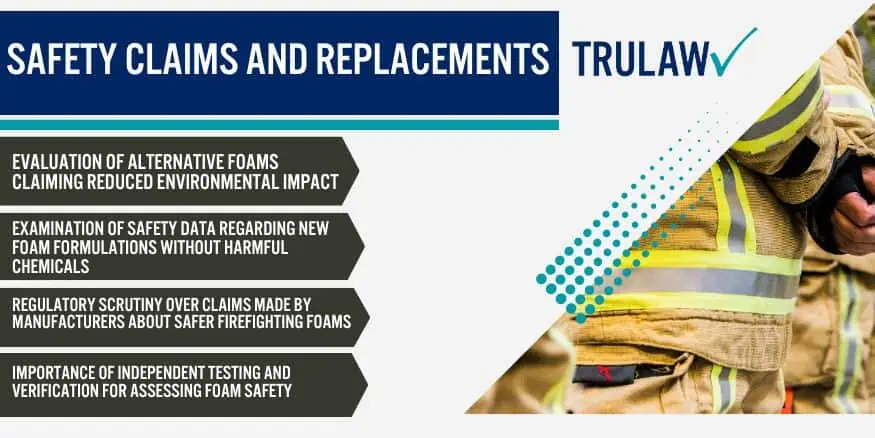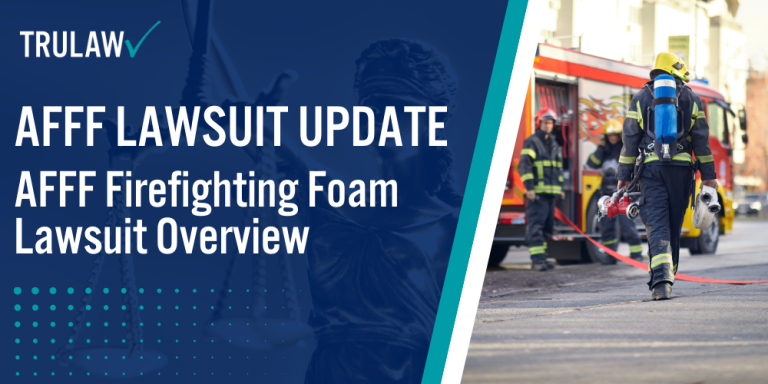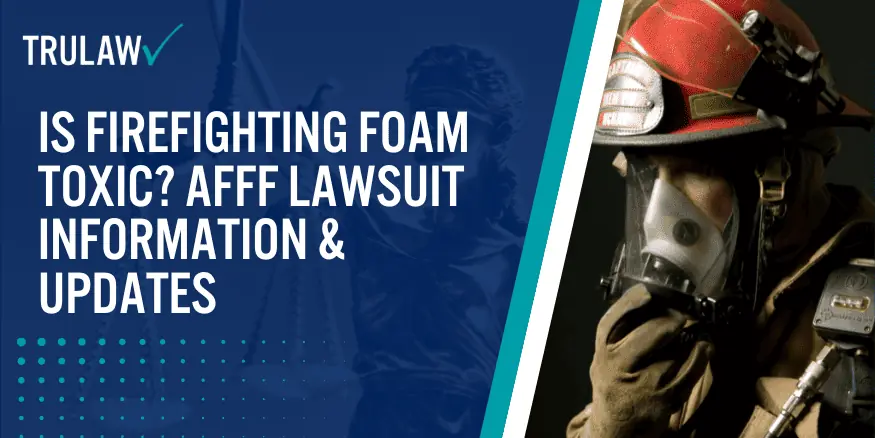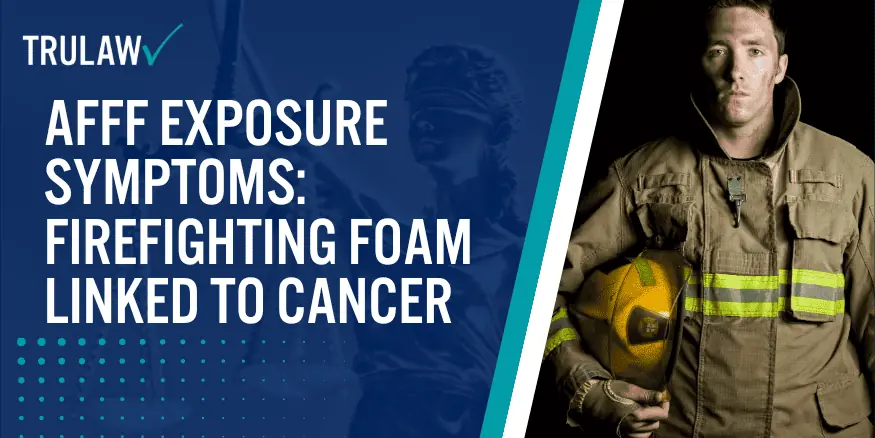Firefighting Foam Exposure: The Crucial Cancer Types Uncovered
- Last Updated: July 9th, 2024

Attorney Jessie Paluch, founder of TruLaw, has over 25 years of experience as a personal injury and mass tort attorney, and previously worked as an international tax attorney at Deloitte. Jessie collaborates with attorneys nationwide — enabling her to share reliable, up-to-date legal information with our readers.
Legally Reviewed
This article has been written and reviewed for legal accuracy and clarity by the team of writers and legal experts at TruLaw and is as accurate as possible. This content should not be taken as legal advice from an attorney. If you would like to learn more about our owner and experienced injury lawyer, Jessie Paluch, you can do so here.
Fact-Checked
TruLaw does everything possible to make sure the information in this article is up to date and accurate. If you need specific legal advice about your case, contact us by using the chat on the bottom of this page. This article should not be taken as advice from an attorney.
Key takeaways:
- Understanding the potential dangers of exposure to AFFF firefighting foam used in fire suppression systems, is crucial for the well-being of firefighters and the general public.
- Personal injury lawyers can help you navigate through the legal process and potentially obtain summary judgment in your favor
- Regulations may require manufacturers to provide detailed documentation, including safety test results and environmental impact assessments for AFFF.
Firefighting Foam Exposure: The Crucial Cancer Types Uncovered
The exposure of firefighters to fluorinated surfactants present in firefighting foam has been scientifically proven to elevate their risk of cancer.
Numerous research studies have established a worrisome correlation between the contact with these chemicals and the onset of several cancers.
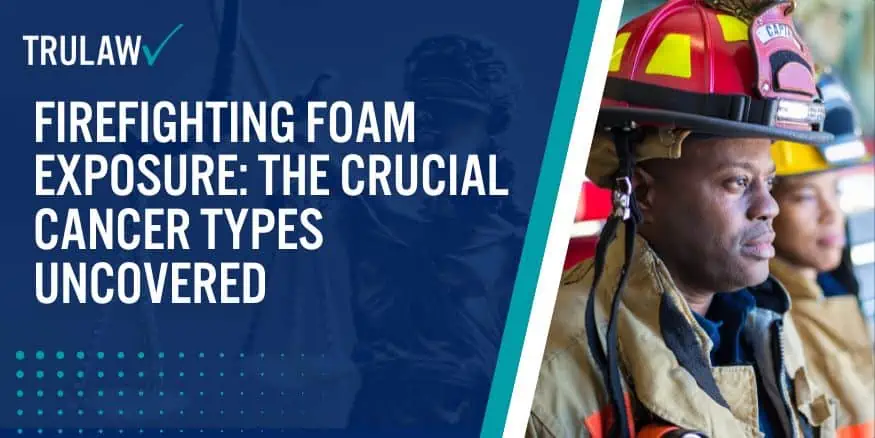
The findings indicate a significant concern regarding the potential health risks for individuals employed in the firefighting industry, particularly when handling oil and liquid fuel fires.
The connection between exposure to firefighting foam and various forms of cancer emphasizes the necessity for additional research and protective actions.
The emphasis is on safeguarding the health and welfare of our courageous firefighters from the hazards of fluorinated chemicals and extinguishing flammable liquid fires with fluorine-free foam and alcohol-resistant foams.
More information will be provided as we further examine the occupational hazards faced by firefighters, the dangers they encounter, and the daily impact on their defense efforts.
Table of Contents
Introduction: Dangers of Firefighting Foam and PFAS Contamination
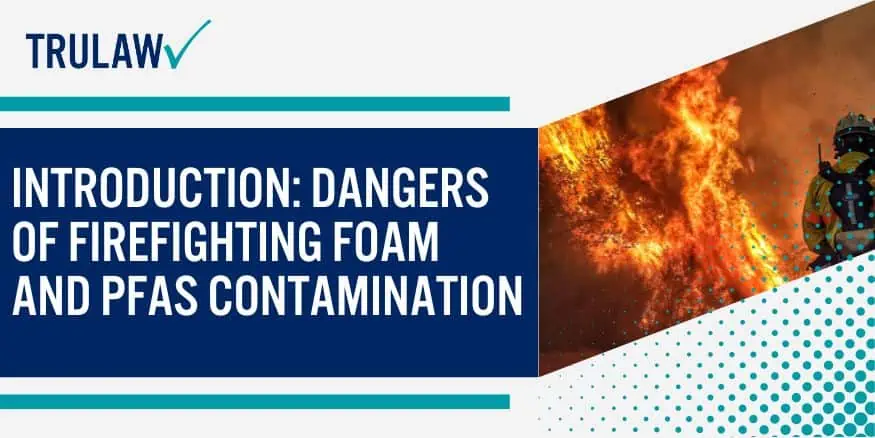
Firefighting foam, a crucial tool in combating fires, contains a hidden danger in the form of per- and poly-fluoroalkyl substances (PFAS), specifically PFOA and PFOS.
These toxic surfactants are present in firefighting foam and pose significant dangers to human health and the environment.
The use of this foam has led to widespread contamination, posing risks to ecosystems, wildlife, and our drinking water sources as high expansion foam.
Firefighting Foam Contains Toxic Chemicals
Firefighters rely on firefighting foam, which contains harmful PFAS chemicals such as PFOA and PFOS surfactants, to suppress fires quickly and effectively.
These new foams are known for their persistence in the environment and resistance to degradation, leading to long-lasting effects on various aspects of our ecosystem.
PFAS Contamination Poses Risks
The release of PFAS, including PFOA and PFOS, from firefighting foam poses significant risks to both human health and the environment.
When these chemicals enter water bodies or soil, they can contaminate drinking water sources and impact aquatic life.
PFAS, such as PFOA and PFOS, can bioaccumulate in organisms higher up the food chain, potentially affecting wildlife populations.
The use of surfactants in fighting liquid fuel fires can contribute to the release of these harmful substances.
Long-lasting Effects on Ecosystems
The introduction of PFOS and PFOA, two types of surfactants, into ecosystems can have far-reaching consequences.
These compounds have been found to persist in the environment for extended periods without breaking down naturally.
As a result, they can accumulate in soil and water systems over time, altering natural processes and disrupting delicate ecological balances.
Potential Adverse Health Effects
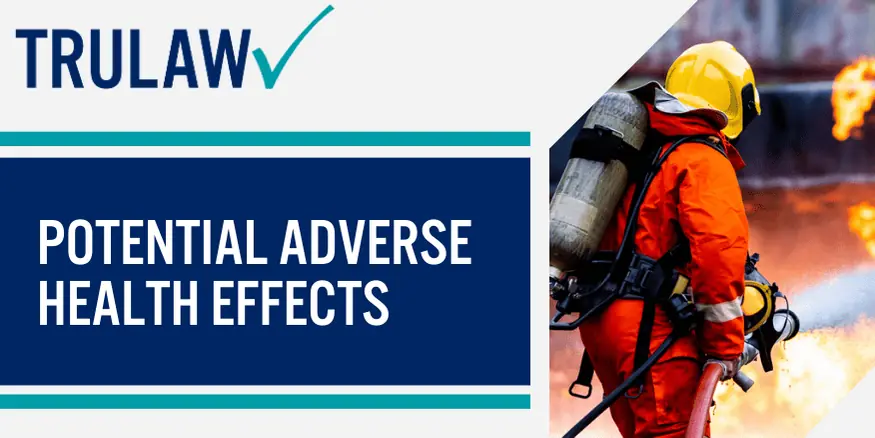
Exposure to PFAS, including PFOA and PFOS, through firefighting foam, has raised concerns about potential adverse health effects on firefighters and those living near contaminated areas.
Studies have linked exposure to PFAS with various health issues such as liver damage, thyroid disorders, immune system dysfunction, reproductive problems, and an increased risk of certain cancers.
These chemicals can also contaminate drinking water sources, posing a risk to public health.
The dangers associated with firefighting foam, such as PFOA and PFOS, extend beyond the immediate risks of fire suppression.
The contamination caused by these chemicals poses long-term threats to our environment and human well-being.
It is crucial to address these risks by exploring new foams and implementing effective measures to prevent further contamination of drinking clean water.
Understanding Firefighting Foams: How They Suppress Fires
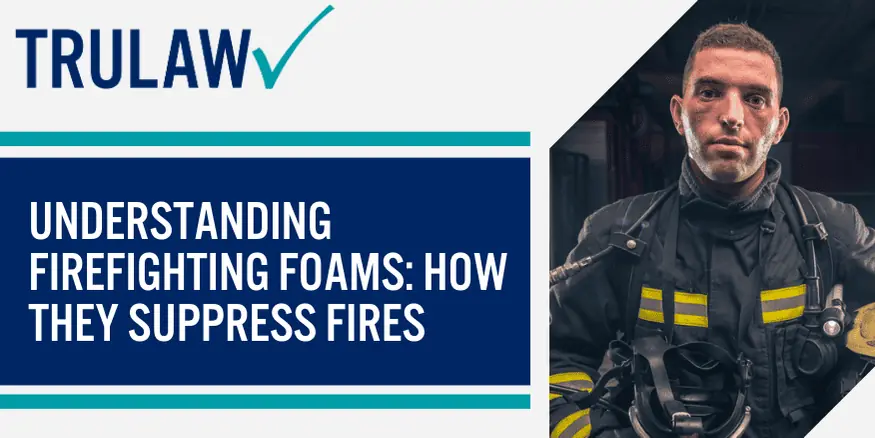
Firefighting foams are essential defense products used by the air force to combat fires.
These specialized foams, including PFOS, effectively suppress fires by smothering them and cutting off their oxygen supply.
One of the key advantages of firefighting foam lawsuits in defense is their ability to create a barrier that prevents rekindling or reignition.
Once applied, the foam forms a protective layer over the fuel source, preventing any residual heat from igniting it again.
This barrier acts as a shield, ensuring that the fire remains extinguished even after the initial suppression efforts by the air force.
Firefighting foams are highly effective in combating fires caused by PFOS-containing products.
It’s important to note that not all firefighting foams, such as PFOS and AFF, used in defense and by the Air Force, are created equal.
Different types of foams, like AFFF, are designed for specific fire classes: A, B, and C.
Class A fires involve ordinary combustible materials such as wood or paper; Class B fires involve flammable liquids like gasoline or oil; and Class C fires involve energized electrical equipment.
Each class requires a different type of foam formulation tailored to combat the unique characteristics of that particular fire class.
For Class A fires, which typically involve solid fuels, low-expansion foams are commonly used.
These foams penetrate porous materials like wood and provide excellent wetting capabilities to cool down hot surfaces while suppressing flames simultaneously.
These foams are effective in combating fires caused by PFOS, PFOA, and other PFAS chemicals.
They are often utilized by the air force to combat such fires.
Class B fires, which involve flammable liquids like gasoline and oil, pose distinct challenges.
High-expansion foams, such as those containing fluorine, are commonly used by the navy and air force to extinguish these fires.
These foams create thick blankets that seal off the fuel source, preventing the release of flammable vapors like PFOS.
Where electricity is involved, specialized foams known as Class C foams are employed to suppress electrical fires.
These foams, which include the chemicals PFOS and PFOA, are specifically designed to extinguish the fire without conducting electricity.
By coating the energized equipment with a layer of foam, they ensure the safety of firefighters and others nearby, including those in the Air Force.
Effectiveness of Firefighting Foams in Extinguishing Fires
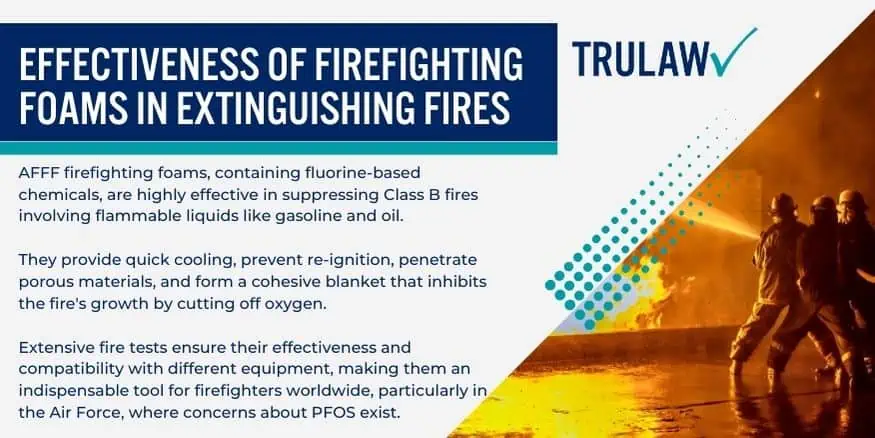
AFFF Firefighting foams, containing chemicals such as fluorine, have proven highly effective in suppressing flammable liquid fires, also known as Class B fires.
These foams, designed specifically for combating fires involving fuels like gasoline and oil, offer several advantages over other methods.
The use of firefighting foams has been particularly important in the Air Force, where the presence of perfluorooctane sulfonate (PFOS) has been a concern.
This quick cooling action significantly reduces the heat release rate and prevents re-ignition, making them effective in combating fires involving PFOS, PFOA, and fluorine.
These foams are commonly used by the air force for their firefighting needs.
Moreover, firefighting foams possess an enhanced ability to penetrate porous materials compared to water alone.
This allows them to reach hidden pockets of fuel within structures or machinery where traditional methods may struggle to reach.
By effectively penetrating these materials, firefighting foams can ensure complete fire suppression and minimize the risk of rekindling.
The unique ability of new foams to form a cohesive blanket over burning surfaces is another critical factor contributing to their effectiveness.
This foam blanket acts as a barrier between the fuel and surrounding air, preventing oxygen from reaching the fire and inhibiting its growth.
This blanket serves as insulation, reducing heat transfer and further aiding in extinguishment efforts.
The use of these new foams also helps to avoid the use of harmful chemicals such as PFOS, PFOA, and fluorine.
In order to gauge the effectiveness of firefighting foams containing PFOS and PFOA under different conditions, extensive fire tests are conducted by the Air Force.
These tests evaluate factors such as burn back resistance, drainage time, expansion ratio, stability under extreme temperatures, and compatibility with different types of equipment.
The results of these tests help ensure that the foam solutions containing fluorine meet the necessary standards for fire suppression.
Firefighting foams, including air force firefighting foams, have become an indispensable tool for fire fighters worldwide, offering a reliable and efficient method to combat Class B fires.
Their ability to rapidly suppress flammable liquid fires, penetrate porous materials, form cohesive blankets, and undergo rigorous testing makes them a crucial component in firefighting operations.
These foams are effective in combating fires involving PFOS, PFOA, and other fluorine-based substances.
Moving Towards Safer Fire Suppression Methods
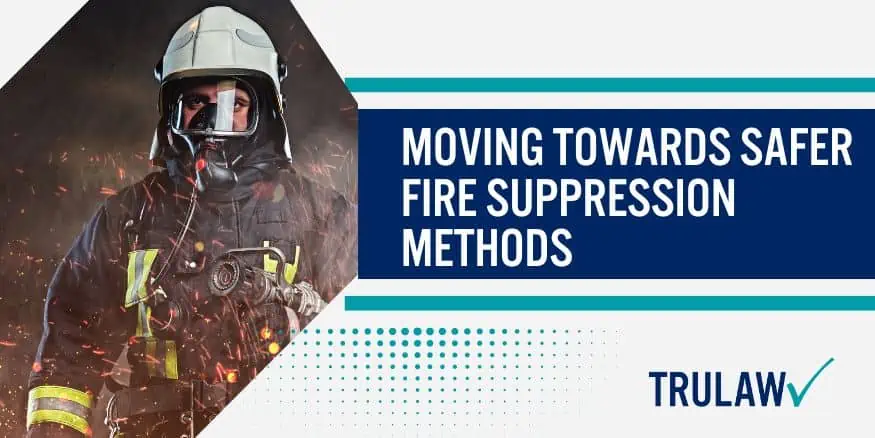
Firefighting foam, containing PFOA and PFOS, has long been a trusted tool in the arsenal of firefighters and municipal fire departments, including the Air Force.
Its ability to quickly extinguish fuel fires and protect lives and property has made it an essential component of fire safety protocols.
However, as we become more aware of the environmental impact of fluorine-containing firefighting foams, there is a growing need to explore safer alternatives and can be guided by AFFF foam lawsuit.
Development and adoption of fluorine-free foams as an alternative
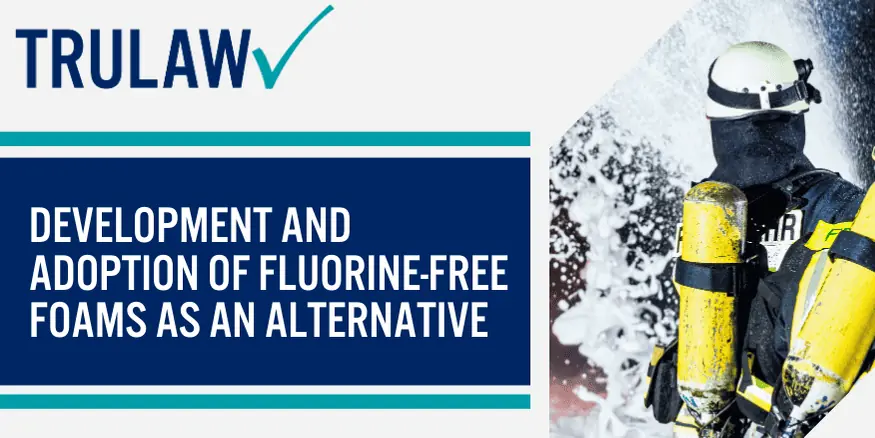
One promising avenue for reducing the ecological footprint of fire suppression is the development and adoption of fluorine-free foams.
Traditional firefighting foams often contain per- and polyfluoroalkyl substances (PFAS), such as PFOA and PFOS, which have been linked to adverse health effects and can persist in the environment for years.
By transitioning to fluorine-free alternatives, we can minimize these risks while still effectively combating fires.
This shift aligns with the guidelines set by the Environmental Protection Agency (EPA) and has also been supported by the Air Force.
Fluorine-free foams, such as PFOA and PFOS, are designed by the Air Force to provide comparable fire suppression capabilities without harmful environmental consequences.
These innovative formulations, known as AFFFs, utilize environmentally friendly agents that do not accumulate in groundwater or pose a threat to ecosystems.
Exploration of innovative technologies for more environmentally friendly fire suppression methods
In addition to fluorine-free foams, there is a need to explore other innovative technologies that offer more environmentally friendly fire suppression methods.
One such approach is high-pressure water mist systems.
These systems use fine water droplets delivered at high velocity to rapidly cool down fires, depriving them of heat energy necessary for sustained combustion.
Compared to traditional sprinkler systems, high-pressure water mist systems use significantly less water while achieving superior fire suppression results.
This is especially important for the Air Force, as they have been seeking alternatives to PFOS and PFOA-containing foams due to environmental concerns raised by the EPA.
Another avenue worth exploring is the use of gasses, such as nitrogen or argon, as a fire suppressant.
Inert gasses displace oxygen from the surrounding environment, creating an atmosphere where combustion cannot occur.
These systems are particularly effective in enclosed spaces or areas with sensitive equipment, as they leave no residue and do not damage valuable assets during fire suppression.
Emphasis on prevention measures and early detection systems
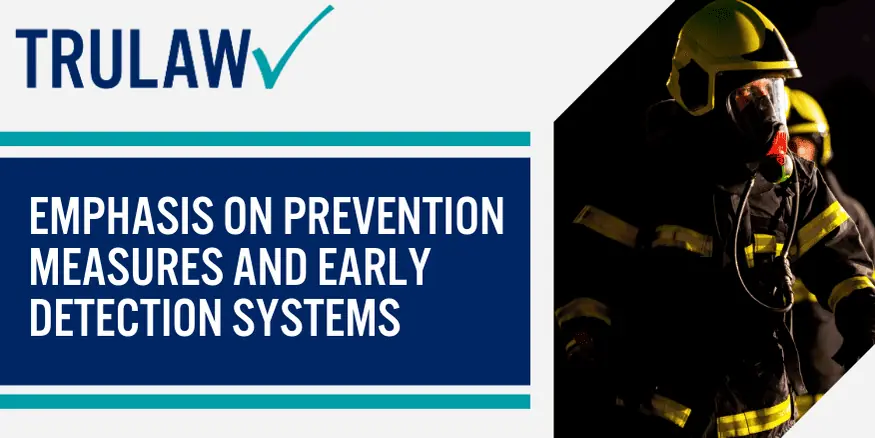
While advancements in fire suppression methods, such as using chemical foam and foam concentrate, are crucial, an equally important aspect of fire safety lies in prevention measures and early detection systems.
By focusing on preventing fires from occurring in the first place, we can significantly reduce the need for aggressive firefighting interventions.
This includes the use of foam blankets and avoiding the use of PFOS.
Fire chiefs and safety officials should prioritize regular inspections of fuel storage areas to identify potential hazards and ensure compliance with safety regulations, including those set by the Environmental Protection Agency (EPA).
Investing in advanced early detection systems, such as smoke detectors, heat sensors, and sophisticated alarm systems, is another key component of comprehensive fire safety strategies.
These systems can provide timely alerts, enabling swift response times and minimizing the spread of fires.
By detecting fires at their earliest stages, these systems help prevent catastrophic damage and save lives.
Persistent PFAS Contamination: The Ongoing Issue with Firefighting Foam
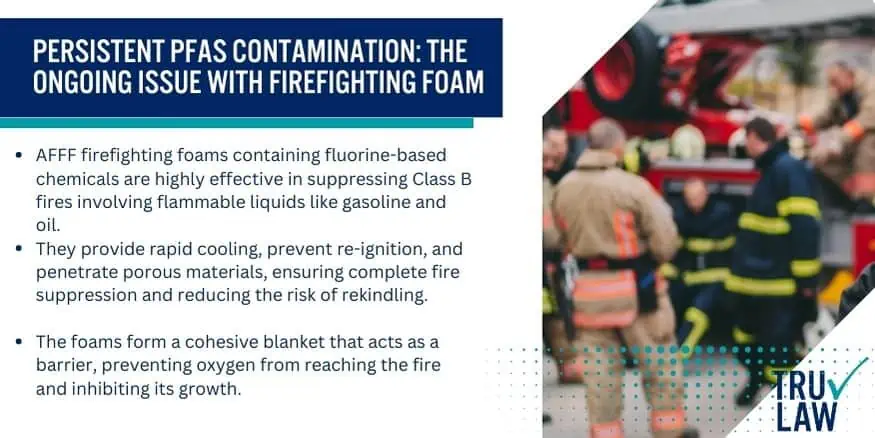
PFAS chemicals, such as PFOS and PFOA, commonly found in firefighting foam (AFFF), have long half-lives and fluorine content, which contribute to their persistent contamination.
This poses significant challenges for cleanup and remediation efforts by the EPA.
The environmental persistence of PFAS compounds means that they can remain in the environment for extended periods, leading to widespread contamination of water sources and ecosystems.
Contaminated water supplies are a major concern due to the presence of PFOS and other fluorine compounds.
These chemicals have the potential to leach into groundwater and surface water, affecting both drinking water sources and aquatic ecosystems.
Once introduced into the environment, PFOS and fluorine compounds can persist for years or even decades, making it difficult to fully eliminate their presence.
This is why organizations like the Fire Fighting Foam Coalition (FFFC) are working to address these issues and develop alternative firefighting foams (AFFF) that are less harmful to the environment.
The persistence of PFAS, including PFOS and fluorine, raises concerns about bioaccumulation in the food chain.
As these chemicals persist in the environment, they can accumulate in plants and animals over time.
This means that organisms higher up in the food chain may be exposed to higher concentrations of PFAS, such as PFOS and fluorine, through consumption of contaminated prey or vegetation.
This bioaccumulation poses risks not only to wildlife but also to humans who consume contaminated fish or other food products.
These concerns have been addressed by organizations like the Fire Fighting Foam Coalition (FFFC), and efforts have been made to develop alternatives, such as AFFF (aqueous film-forming foam), to reduce the use of PFAS-containing fire-fighting foams.
Firefighting training exercises conducted by the Navy continue to release PFOS and other PFAS compounds into the environment.
These exercises involve the use of firefighting foam, known as AFFF, as a premix solution to simulate real-life scenarios.
However, this practice exacerbates the issue of persistent contamination, as it leads to the release of PFAS compounds into soil and water systems surrounding training sites.
The EPA is actively addressing this concern.
Efforts are being made by the EPA and Navy to address the ongoing issue of PFOS and AFFF contamination caused by firefighting foam.
Cleanup and remediation strategies aim to mitigate the impacts on affected areas by removing or treating contaminated soil and water sources.
Technologies such as activated carbon filtration systems are being employed to remove PFAS from drinking water supplies.
In addition to cleanup efforts, there is a growing focus on prevention and regulation regarding firefighting foam use.
Many organizations, including the Navy, are transitioning towards fluorine-free foams that do not contain PFOS compounds.
This shift aims to reduce the release of these persistent chemicals into the environment and minimize the risks associated with their contamination.
The EPA is also involved in regulating the use of AFFF to address environmental concerns.
Impact of Toxic Firefighting Foam Use by the Military on Environment and Public Health
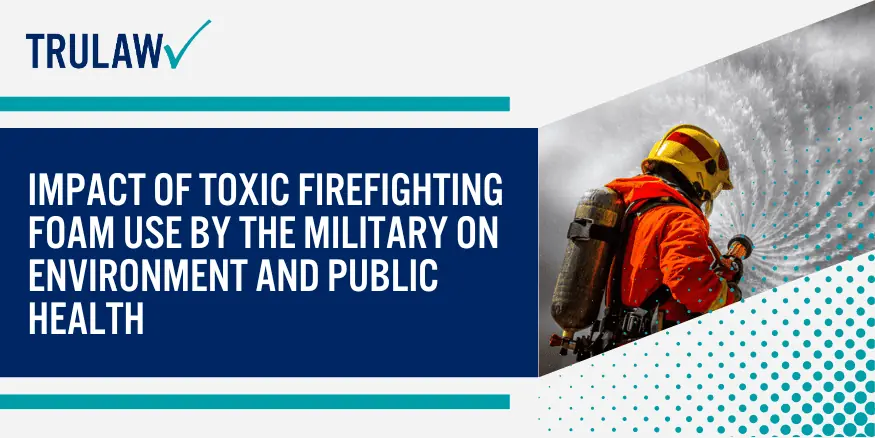
The widespread use of per- and polyfluoroalkyl substances (PFAS) in firefighting foam by military branches, such as the navy, has had a significant impact on the environment and public health.
This toxic foam, known as Aqueous Film Forming Foam (AFFF), is commonly used to combat high-intensity fires.
Unfortunately, it has resulted in severe contamination of soil, groundwater, and surface water near military bases.
The Environmental Protection Agency (EPA) is actively addressing this issue.
The military, including the Air Force and Navy, has long relied on PFAS-containing firefighting foam, such as PFOS and AFFF, due to its effectiveness in extinguishing fuel-based fires.
However, the chemicals present in these foams, as identified by the EPA, have proven to be highly persistent in the environment.
As a result, they have seeped into surrounding ecosystems, causing extensive damage.
One of the most concerning aspects is the health risks faced by military personnel exposed to these toxic firefighting foam chemicals, such as PFOS and AFF.
PFAS compounds have been linked to a range of adverse health effects, including liver damage, immune system dysfunction, hormonal disruptions, and an increased risk of certain cancers.
The exposure primarily occurs through inhalation or ingestion during navy training exercises or emergency response situations.
Not only does this pose a threat to human health within the military community, including the Navy, but it also impacts nearby civilian populations.
The contamination can spread beyond military bases through air and water pathways, potentially affecting communities living in close proximity.
Health advisories have been issued cautioning against consuming fish from contaminated water sources or using well water located near affected areas.
This is a concern for both the military and municipal fire departments, as well as organizations like the fire fighting foam coalition, who are working to address fuel fire risks.
Furthermore, the financial burden associated with cleanup efforts at military sites heavily falls upon governments and fire departments.
The cost of remediating soil and water contaminated with PFAS, a persistent chemical found in firefighting foam used by the Navy and other organizations, can be exorbitant.
It requires extensive measures such as pumping out contaminated groundwater or implementing advanced treatment technologies recommended by the firefighting foam coalition.
To mitigate immediate risks posed by drinking water contaminated with PFAS near affected regions, authorities often provide bottled water supplies as an interim solution while long-term remediation efforts take place.
The U.S. Department of Defense has been actively working to develop and implement alternative firefighting foams that are free from PFAS from AFFF cancer lawyer advice, aiming to reduce the environmental and health impacts associated with their use.
This is especially important for the navy, which relies on firefighting foams like AFFF.
Environmental Concerns Surrounding PFAS and Firefighting Foam
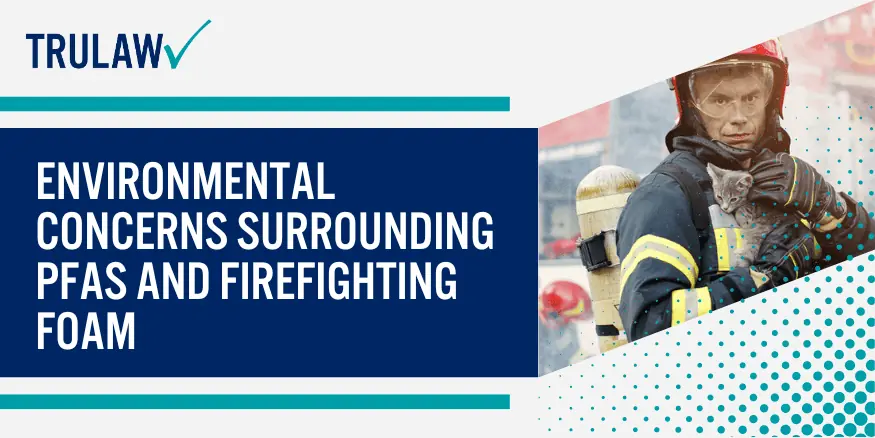
Firefighting foam, also known as fluoroprotein foam or fluorinated surfactant, has long been used by the navy to combat polar solvent fires in various settings such as petroleum facilities and airports.
However, the use of firefighting foam, specifically AFFF (aqueous film-forming foam), has raised significant environmental concerns due to the presence of per- and polyfluoroalkyl substances (PFAS) chemicals.
One major issue is the bioaccumulation of PFAS in wildlife, which can lead to ecological imbalances.
PFAS chemicals, commonly found in fire fighting foam used by fire departments and the navy (AFFF), have been found to accumulate in the bodies of fish, birds, and other animals that inhabit contaminated environments.
As these animals consume prey or plants containing PFAS, the concentration of these harmful chemicals increases within their tissues over time.
This bioaccumulation not only poses a threat to the affected species but also disrupts entire food chains within ecosystems.
Moreover, PFAS contamination in water bodies has proven to be highly disruptive to aquatic ecosystems, particularly the navy.
When firefighting foam containing AFFF and fluorinated surfactants is used near water sources or during fire suppression activities involving flammable liquids, it can contaminate rivers, lakes, and groundwater reserves.
The persistence of PFAS in water leads to long-term pollution that affects aquatic organisms and their habitats, including the navy.
These chemicals have been linked to reproductive issues and developmental abnormalities in fish and other aquatic life, including the navy.
The exposure of endangered species to PFAS-contaminated environments, such as contaminated water or prey items, is another grave concern.
Endangered animals, like those in the navy, are often more vulnerable due to their limited populations and specific habitat requirements.
This contact with PFAS can have severe consequences for their health and survival.
The impact on endangered species further emphasizes the urgent need for stricter regulations regarding AFFF usage.
In addition to local contamination, airborne particles carrying PFAS from firefighting foam containing fluorinated chemicals, such as AFFF, have the potential for long-distance transport, impacting even remote areas far from their original source.
These airborne particles can travel through wind currents, settling in previously unaffected regions.
As a result, areas that were once considered pristine and untouched may now face the consequences of PFAS pollution caused by the navy.
This highlights the far-reaching environmental impact of firefighting foam containing fluorinated chemicals used by the navy.
The Environmental Protection Agency (EPA) and other regulatory bodies have recognized the significance of environmental concerns surrounding PFAS and firefighting foam, including the navy’s use of AFFF.
Efforts are being made to address this issue, including research on alternative firefighting agents and regulations on the use and disposal of PFAS-containing foams.
The Federal Aviation Administration (FAA), for example, has phased out the use of certain PFAS-based foams in airport operations to reduce environmental impact.
Safety Claims and Replacements: Assessing the Reassurances of Chemicals Used in Firefighting Foam
Evaluation of alternative foams claiming reduced environmental impact
As concerns about the environmental impact of firefighting foam, specifically AFFF, continue to grow, manufacturers have been striving to develop alternative foams that offer a reduced ecological footprint.
These new formulations aim to address the issue of harmful chemicals leaching into soil and water sources during firefighting operations, based on AFFF Lawyers.
By evaluating these alternative foams, we can determine their effectiveness in reducing environmental harm while still maintaining their firefighting capabilities.
Examination of safety data regarding new foam formulations without harmful chemicals
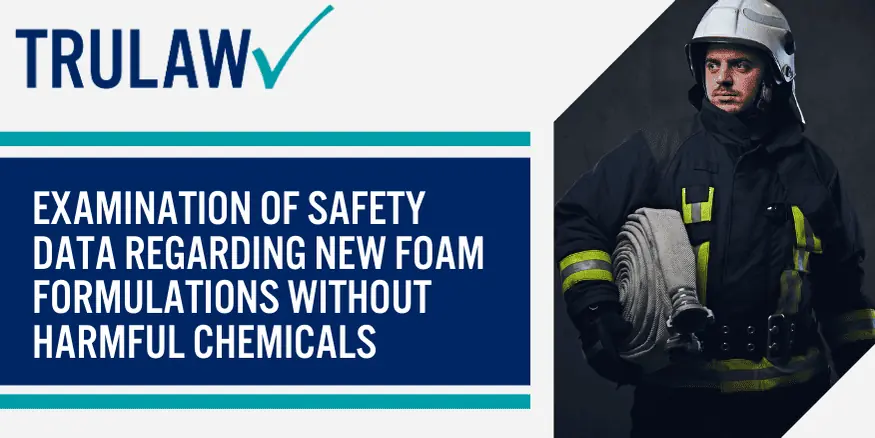
To assess the safety claims made by manufacturers regarding new foam formulations without harmful chemicals, fire departments must thoroughly examine the available safety data.
Independent testing and verification conducted by fire departments play a crucial role in evaluating the potential risks associated with these alternative foams, such as AFFF.
By analyzing comprehensive safety data, we can determine whether these new AFFF foam formulations pose any health hazards to fire departments or if they are indeed safer alternatives.
This examination should include assessments of toxicity levels, potential allergic reactions, and any adverse effects on human health or the environment.
Furthermore, it is vital to consider real-world scenarios where these AFFF foams are deployed to ensure their efficacy under various conditions.
Regulatory scrutiny over claims made by manufacturers about safer firefighting foams
Given the significance of public safety and environmental protection, regulatory bodies closely scrutinize claims made by manufacturers about safer firefighting foams, such as AFFF.
These organizations aim to ensure that any assertions regarding reduced chemical use or improved eco-friendliness are substantiated by scientific evidence and comply with established safety standards.
Regulations may require manufacturers to provide detailed documentation, including safety test results and environmental impact assessments for AFFF.
This regulatory scrutiny serves as an additional layer of assurance for firefighters and the public, assuring them that the AFFF foams being used are genuinely safer alternatives.
By adhering to these regulations, manufacturers demonstrate their commitment to transparency and accountability for AFFF.
Importance of independent testing and verification for assessing foam safety
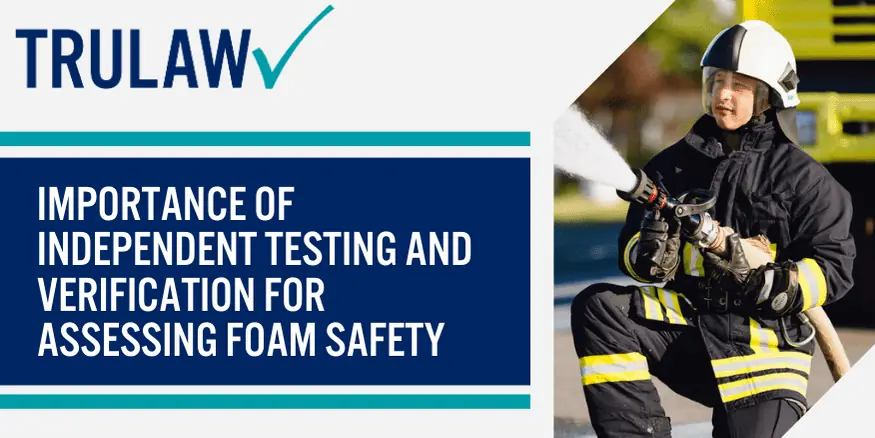
Independent testing and verification are crucial in assessing the safety of firefighting foams, including AFFF.
These processes involve subjecting foams to rigorous scientific evaluation by reputable third-party organizations.
Through this independent scrutiny, potential biases or conflicts of interest can be eliminated, ensuring reliable results for AFFF.
By relying on independent testing and verification, we can obtain objective information about AFF foam safety.
This includes evaluating factors such as chemical composition, effectiveness in suppressing fires, environmental impact, and potential health risks.
Independent assessment provides an unbiased perspective that helps inform decisions regarding the adoption of alternative foams like AFFF in firefighting operations.
Conclusion
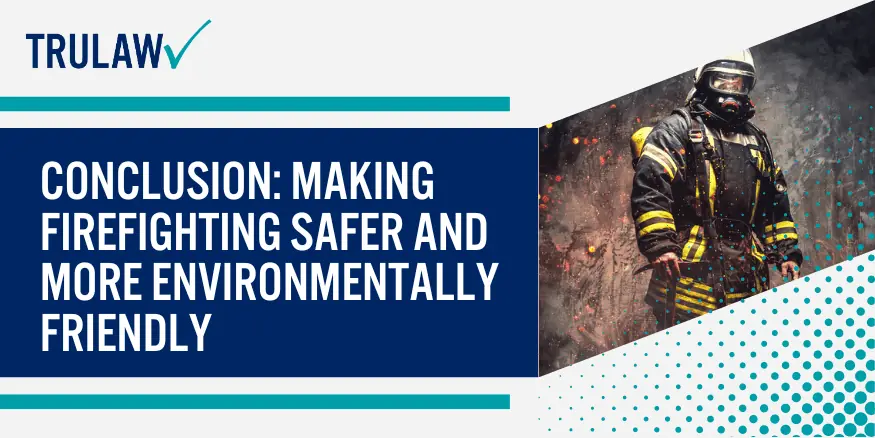
In conclusion, the use of firefighting foam has proven to be highly effective in suppressing fires and protecting lives.
However, the dangers associated with traditional foams containing harmful chemicals, such as PFAS, cannot be ignored.
The persistent contamination caused by these chemicals poses a significant threat to both the environment and public health.
As we move towards safer fire suppression methods, it is crucial to explore alternatives that offer comparable performance without compromising our well-being.
They provide an excellent solution in this regard.
By eliminating harmful chemicals from their formula, they ensure that firefighters can effectively combat fires without risking long-term health consequences.
The environmental concerns surrounding PFAS and firefighting foam are pressing issues that demand immediate attention.
The ongoing contamination caused by these substances poses a threat to ecosystems and water sources across the globe.
It is essential for authorities and industries to take proactive measures to address this problem and minimize further damage.
When assessing safety claims and replacements for firefighting foam, it is imperative to consider the reassurances provided by manufacturers.
Their commitment to using non-toxic ingredients ensures a safer working environment for firefighters while maintaining high levels of fire suppression effectiveness.
By supporting companies and firefighting foam cancer lawsuits that prioritize sustainability and safety, we can contribute towards mitigating the adverse impacts caused by traditional firefighting foam.
Frequently Asked Questions
-
How Can The Effectiveness Of Alternative Foams In Reducing Environmental Harm Be Assessed?
Evaluating the effectiveness of alternative foams in reducing environmental harm involves examining their firefighting capabilities while considering their ecological footprint.
This assessment typically consists in analyzing safety data, conducting independent testing, and verifying claims made by manufacturers regarding reduced chemical use and improved eco-friendliness.
Real-world deployment scenarios are also considered to ensure efficacy under various conditions.
-
What Factors Should Fire Departments Consider When Examining The Safety Of New Foam Formulations Without Harmful Chemicals?
Fire departments should consider comprehensive safety data when examining the safety of new foam formulations without harmful chemicals.
This includes assessing toxicity levels, potential allergic reactions, and adverse effects on human health or the environment.
Real-world scenarios where these foams are deployed should also be considered to ensure their effectiveness and safety.

Experienced Attorney & Legal SaaS CEO
With over 25 years of legal experience, Jessie is an Illinois lawyer, a CPA, and a mother of three. She spent the first decade of her career working as an international tax attorney at Deloitte.
In 2009, Jessie co-founded her own law firm with her husband – which has scaled to over 30 employees since its conception.
In 2016, Jessie founded TruLaw, which allows her to collaborate with attorneys and legal experts across the United States on a daily basis. This hypervaluable network of experts is what enables her to share reliable legal information with her readers!
You can learn more about the AFFF Lawsuit by visiting any of our pages listed below:
Here, at TruLaw, we’re committed to helping victims get the justice they deserve.
Alongside our partner law firms, we have successfully collected over $3 Billion in verdicts and settlements on behalf of injured individuals.
Would you like our help?
At TruLaw, we fiercely combat corporations that endanger individuals’ well-being. If you’ve suffered injuries and believe these well-funded entities should be held accountable, we’re here for you.
With TruLaw, you gain access to successful and seasoned lawyers who maximize your chances of success. Our lawyers invest in you—they do not receive a dime until your lawsuit reaches a successful resolution!
Do you believe you’re entitled to compensation?
Use our Instant Case Evaluator to find out in as little as 60 seconds!
Camp Lejeune’s water contamination issue spanned several decades starting in the 1950s. Exposure to these chemicals has been linked to various serious health issues, including cancer, organ diseases, and death.
Research is increasingly suggesting a link between the use of Tylenol during pregnancy and the development of neurodevelopmental disorders, such as autism and ADHD, in infants.
Legal action is being taken against manufacturers of Aqueous Film-Forming Foam (AFFF), a chemical used in fighting fires. The plaintiffs allege that exposure to the foam caused health issues such as cancer, organ damage, and birth and fertility issues.
Here, at TruLaw, we’re committed to helping victims get the justice they deserve.
Alongside our partner law firms, we have successfully collected over $3 Billion in verdicts and settlements on behalf of injured individuals.
Would you like our help?
